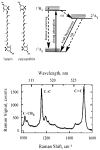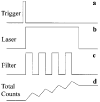Simple Raman instrument for in vivo detection of macular pigments
- PMID: 16053555
- PMCID: PMC3079574
- DOI: 10.1366/0003702054411616
Simple Raman instrument for in vivo detection of macular pigments
Abstract
Raman spectroscopy holds promise as a novel noninvasive technology for the quantification of the macular pigments (MP) lutein and zeaxanthin. These compounds, which are members of the carotenoid family, are thought to prevent or delay the onset of age-related macular degeneration, the leading cause of irreversible blindness in the elderly. It is highly likely that they achieve this protection through their function as optical filters and/or antioxidants. Using resonant excitation in the visible region, we measure and quantify the Raman signals that originate from the carbon double bond (C=C) stretch vibrations of the pi-conjugated molecule backbone. In this manuscript we describe the construction and performance of a novel compact MP Raman instrument utilizing dielectric angle-tuned band-pass filters for wavelength selection and a single-channel photo-multiplier for the detection of MP Raman responses. MP concentration measurements are fast and accurate, as seen in our experiments with model eyes and living human eyes. The ease and rapidity of Raman MP measurements, the simplicity of the instrumentation, the high accuracy of the measurements, and the lack of significant systematic errors should make this technology attractive for widespread clinical research.
Figures









Comment in
-
Comments on the use of Raman spectroscopy for the in vivo measurement of human macular pigment.Appl Spectrosc. 2006 Nov;60(11):1348-9; author reply 1350-1. doi: 10.1366/000370206778999067. Appl Spectrosc. 2006. PMID: 17132455 No abstract available.
Similar articles
-
Macular pigment Raman detector for clinical applications.J Biomed Opt. 2004 Jan-Feb;9(1):139-48. doi: 10.1117/1.1627776. J Biomed Opt. 2004. PMID: 14715066 Free PMC article.
-
In vivo resonant Raman measurement of macular carotenoid pigments in the young and the aging human retina.J Opt Soc Am A Opt Image Sci Vis. 2002 Jun;19(6):1172-86. doi: 10.1364/josaa.19.001172. J Opt Soc Am A Opt Image Sci Vis. 2002. PMID: 12049355
-
Noninvasive detection of macular pigments in the human eye.J Biomed Opt. 2004 Jan-Feb;9(1):75-85. doi: 10.1117/1.1628240. J Biomed Opt. 2004. PMID: 14715058 Review.
-
Resonance Raman detection of carotenoid antioxidants in living human tissue.J Biomed Opt. 2005 Nov-Dec;10(6):064028. doi: 10.1117/1.2139974. J Biomed Opt. 2005. PMID: 16409093 Free PMC article. Review.
-
Resonance Raman measurement of macular carotenoids in normal subjects and in age-related macular degeneration patients.Ophthalmology. 2002 Oct;109(10):1780-7. doi: 10.1016/s0161-6420(02)01173-9. Ophthalmology. 2002. PMID: 12359594 Free PMC article.
Cited by
-
Review of clinical approaches in fluorescence lifetime imaging ophthalmoscopy.J Biomed Opt. 2018 Sep;23(9):1-20. doi: 10.1117/1.JBO.23.9.091415. J Biomed Opt. 2018. PMID: 30182580 Free PMC article. Review.
-
Fluorescence lifetime imaging ophthalmoscopy.Prog Retin Eye Res. 2017 Sep;60:120-143. doi: 10.1016/j.preteyeres.2017.06.005. Epub 2017 Jun 30. Prog Retin Eye Res. 2017. PMID: 28673870 Free PMC article. Review.
-
Harnessing the power of Raman spectroscopic imaging for ophthalmology.Front Chem. 2023 May 12;11:1211121. doi: 10.3389/fchem.2023.1211121. eCollection 2023. Front Chem. 2023. PMID: 37252371 Free PMC article. Review.
-
Multimodal, label-free fluorescence and Raman imaging of amyloid deposits in snap-frozen Alzheimer's disease human brain tissue.Commun Biol. 2021 Apr 15;4(1):474. doi: 10.1038/s42003-021-01981-x. Commun Biol. 2021. PMID: 33859370 Free PMC article.
-
Resonance Raman based skin carotenoid measurements in newborns and infants.J Biophotonics. 2013 Oct;6(10):793-802. doi: 10.1002/jbio.201200195. Epub 2012 Nov 29. J Biophotonics. 2013. PMID: 23193015 Free PMC article.
References
-
- Schalch W, Dayhaw-Barker P, Barker FM. The carotenoids of the human retina. In: Taylor A, editor. Nutritional and Environmental Influences on the Eye. CRC; Boca Raton, FL: 1999. pp. 215–250.
-
- Seddon JM, Ajani UA, Sperduto RD, Hiller R, Blair N, Burton TC, Farber MD, Gragoudas ES, Haller J, Miller DT, Yanuzzi LA, Willet W. J Am Med Assoc. 1994;272:1413. - PubMed
-
- Beatty S, Koh H-H, Henson D, Boulton M. Surv Ophthalmol. 2000;45:115. - PubMed
-
- Reading VM, Weale RA. J Am Optom Assoc. 1974;64:231.
-
- Beatty S, Murray IJ, Henson DB, Carden D, Koh H-H, Boulton ME. Invest Ophthalmol Visual Sci. 2001;42:439. - PubMed
Publication types
MeSH terms
Substances
Grants and funding
LinkOut - more resources
Full Text Sources
Medical
Research Materials
Miscellaneous

